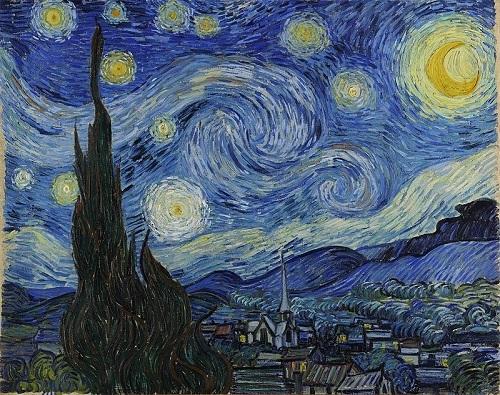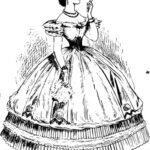
Vincent van Gogh’s The Starry Night is one of the most famous paintings in the history of art, inspiring and influencing multitudinous artists across many fields. Two such artists are the American poet Anne Sexton, and the American songwriter Don McLean, both of whom dedicated one of their respective artworks to the Dutch painter and his painting: Sexton in her poem, “The Starry Night” (1961), and McLean in his song, “Vincent” (1971).
Whereas both of these compositions doubtlessly convey quite a gloomy sentiment, there is also an acute difference between them: McLean offers an empathetic account of van Gogh’s tortured life, and Sexton extends The Starry Night’s induced despondency to the speaker of the poem, presumably herself.
The two different approaches in the artworks of Sexton and McLean are quite evident in their perspectival position. The speaker in “The Starry Night” presents a sinister portrayal of van Gogh’s painting, which is connected to her own personal feelings. For instance, she grimly likens the “black-haired tree” in the painting to “a drowned woman” and menacingly states how the “night boils with eleven stars” to describe the sky.
Unlike Sexton’s self-reflexive somber depiction that van Gogh’s painting evokes, McLean describes elements from various van Gogh’s paintings by directly addressing him. For instance, with regard to The Starry Night, McLean tells van Gogh to “[p]aint [his] palette blue and grey” as the prevalent hues in the painting and that even “on a summer’s day” van Gogh sees “[w]ith eyes that know the darkness in [his] soul / Shadows on the hills.” Hence, even though McLean’s description relates wistfully to van Gogh and his art, it certainly does not impart the same fatal sense as in Sexton’s poem.
Perhaps what can accurately demonstrate best each artwork’s tone is the repetition in each one. The speaker in Sexton’s “The Starry Night” repeats twice the lines, “Oh starry night! This is how / I want to die” – clearly an ominous and suicidal affirmation of the speaker based on van Gogh’s personal account of ultimately killing himself. In comparison, the repetition of the chorus in McLean’s “Vincent” is characterized by deep sorrowful empathy rather than a sentimental extension of the speaker’s glum emotions. This attitude can be distilled to the chorus’s line, “Now I understand” – an empathetic admission of the speaker’s compassionate position regarding van Gogh. There is, therefore, a clear disparity between the recurring parts in each composition: in Sexton’s poem, it is distinguished by fatalism, and in McLean’s song, it expresses understanding and empathy.
The form of each artwork also inspires a completely different impression: while McLean’s song has a very organized and ordered structure, Sexton’s poem seems intentionally erratic. Sexton’s poem begins with a quote from one of van Gogh’s letters to his brother and then three stanzas of varied lines’ length and no rhyme scheme at all; this fickle form is perhaps designated to reflect van Gogh’s own volatile life, the painting’s ambiance, and the speaker’s precarious mindset. In contrast, McLean’s song is constructed neatly in the traditional stanza-chorus structure with a consistent rhyme scheme, which projects far more general serenity and tranquility than Sexton’s poem, and thus allows much more room for empathy to the tormented painter.
Both artworks end in pessimistic spirits; yet, whereas the ending in McLean’s song conveys a certain critique of society’s regard for artists like van Gogh, the ending in Sexton’s poem expresses the speaker’s disturbing desire to die. The speaker in “The Starry Night” forebodingly indicates that she wants “to split / from [her] life with no flag, / no belly, / no cry” – evidently a suicidal assertion of the speaker who asks not to associate her desired death wish with patriotism (flag), or the ability to procreate (belly), or self-pity (cry), seemingly as van Gogh’s death. In McLean’s song, however, the ending relates to society’s inability to understand van Gogh rather than suicidal yearning as in Sexton’s poem. At the end of “Vincent,” the speaker repeats the recurring chorus line, “They would not listen, they’re not listening still” – criticizing society for not attempting to understand artists such as van Gogh – but then, instead of the previously recurring line, “Perhaps they’ll listen now,” the speaker speculates that “[p]erhaps they never will,” conveying his pessimistic view that society might never understand artists like van Gogh.
Anne Sexton’s “The Starry Night” and Don McLean’s “Vincent” offer two unique ekphrastic accounts of Vincent van Gogh’s The Starry Night. While in both artworks there are inherent morose undertones, in Sexton’s poem, the speaker employs van Gogh’s painting to communicate her own bleak and suicidal emotions, and McLean’s song revolves around the speaker’s empathetic lamentation of van Gogh’s tragic life and fate. In my humble opinion, Sexton’s poem is much more poignant and evocative of van Gogh’s disturbed psyche, while McLean presents a look at van Gogh and his art entirely from the outside; thus, I personally find the speaker’s agonizing perspective in Sexton’s poem a little more affecting and touching than the mournful speaker in McLean’s song.



